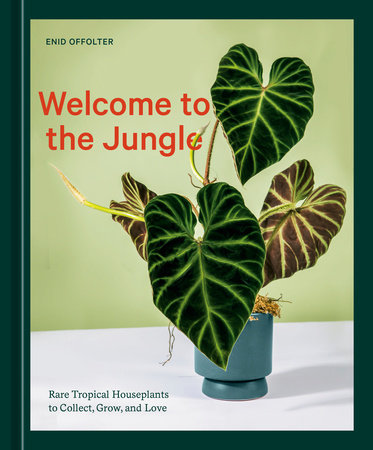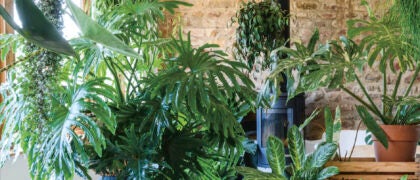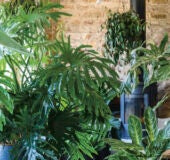Introduction
Why Do We Love Plants?Many of us are living in unnatural environments that are far removed from nature, in crowded apartment complexes on congested streets with bustling sidewalks. Studies have shown that nature deprivation is a prime cause of depression and anxiety; the more we are distanced from nature, the more anxiety we feel. It’s no wonder that filling our homes with plants brings us peace and inspires us. Plants bring us joy and create calm. Walk into a green space, pause, close your eyes, take a deep breath, and pay attention to how you feel. Plants add so much life to a space, and they oxygenate and refresh the air we breathe. Taking care of plants gives us a way to nurture living things. It’s just human nature to feel a sense of pride as each new leaf unfurls and it’s wonderful to know that these beautiful, green beings depend on us for their care. Another amazing part of growing houseplants is the connection we share with an incredible community of fellow plant lovers. So many friendships are forged around common plant interests. I’ve met some of my best friends through our shared interest in plants.
In the two decades I’ve been collecting, I have amassed quite a few plants. It’s my life. Like many other plant enthusiasts, my collection grew to a sizable number of common houseplants, such as fiddle-leaf fig (
Ficus lyrata) and Swiss cheese plant (
Monstera deliciosa), which thrived without any special care. These and many other popular houseplants are mass produced and easy to acquire and maintain. But eventually I was ready to kick it up a notch and add some extraordinary plants to my collection. If you’re ready to add diversity to your plant collection, you’ll find plenty of suggestions in this book on how to find and care for extraordinary plants, many of which are so beautiful they almost defy description.
Graduating from Common to Extraordinary Houseplants
I have always been interested in plants, nature, and anything unusual or different. Anytime I moved into a new house or apartment, the first thing on my to-do list would be to visit the local nursery and buy as many young plants and bags of topsoil as I could afford to make a garden in front of my new home. Before unpacking and before painting, I would plant a garden. I find it incredibly welcoming to come home and be surrounded by plants. To me, plants are the most important part of making a house a home.
In 1999, I discovered that I could buy plants on eBay. (Who knew, right?) As I became addicted to the thrill of winning plants at auction, it became apparent that I needed a way to fund my new plant addiction. So I started an online business from my Florida home, selling seeds on eBay—seeds that I would purchase in bulk and sell in smaller lots, or seeds that I collected from my own garden. When other sellers started offering seeds on eBay, I took it as a sign of my success. Imitation is the sincerest form of flattery, I suppose.
Eventually, to make more money to support my plant collecting habit and to increase my own collection, I began visiting nurseries and buying pots full of easy-to-grow plants, which I would divide and sell online. After a successful day of buying, I’d return home with a carload of plants, and then the real work would begin. I would divide the plants into several smaller clumps and repot the divisions, placing them on a makeshift plant bench to get them established. Some of these repotted plants would be sold online, and some I would keep for myself. This quickly spiraled out of control, however, and soon I had thousands of plants to care for—or maybe even hundreds of thousands!
When I started selling plants on the internet, most of the nursery owners I knew didn’t take online plant sales seriously. In fact, I was actually embarrassed to admit that I sold plants on eBay. At that time, most of the nursery owners I knew were dismissive of my online nursery and plant shipping business. Today, however, some of those same people call me for advice on identifying plants and help with selling them online!
More and More Plants
After a while, I figured out how to build my own website, NSE Tropicals. Selling rare and unusual plants online was pretty easy, and there still wasn’t a lot of competition at the time. Nevertheless, most buyers preferred to order from printed catalogs or chose to visit brick-and-mortar nursery locations, and some didn’t believe this was a legitimate business because online plant sales were so new. So I began attending plant shows, providing landscaping services, and eventually opened a retail nursery. I did whatever it took to get by. Despite buying tons of advertising, my retail nursery location wasn’t producing enough income to make a decent living. There simply wasn’t enough local interest in rare plants, and I realized that the internet was the only way to reach buyers from across the United States. After three hurricanes in one year, and then the birth of my son (so make that four hurricanes), I realized that maintaining the nursery was actually more of a hindrance than a help. So after some thought, I went back to strictly online. That was the best decision ever. I often think it’s crazy how hard I tried to get people to visit the nursery back then, while now I have to fight to keep them out because of the national popularity of NSE Tropicals.
Today, at NSE Tropicals, I propagate most of my new plants from my own collection. My Florida operation includes a greenhouse and three shade houses (structures that provide some shade but, unlike the greenhouse, are open to outside air circulation). Most of the plants grow best in either the greenhouse or in the wall shade house because the bright summer light in the other two shade houses can stress the plants. In the wall shade house is my first—and best—living wall (a vertical plant installation mounted on the wall), where water runs down the wall of plants and breezes blow across it, making the shade house much cooler than the other two. My plants find it way more pleasant and they like it best—at least that’s what they told me. I work in this shade house most of the time, and it also seems to be a favorite hangout for a diversity of life besides plants. With so many leafy places to hide and so much available water, it is home to many species of lizards, frogs, and the occasional snake. These guys help me out by devouring any pests they find.
The Jump to Aroids
There is no greater excitement than finding and growing new plants. As my plant collection has grown, my search for new additions has driven me to find more and more unusual and rare plants. When I visit a nursery, it seems I am constantly drawn to plants that aren’t for sale. (Often, the more interesting and rare the plant, the less likely it will be for sale, because the nursery owner appreciates the plant too much to send it off to another home.) Because I’ve always been interested in the more unusual plants that the world has to offer, when I discovered aroids, I was hooked.
Aroids are a common name for the Araceae, or arum, family of tropical plants, known for their spectacular and leathery foliage, crazy inflorescences (flower clusters), and weird growth habits, which make them irresistible. Some aroids, such as the spiny
Lasia spinosa, have spiraling inflorescences that resemble unicorn horns. Others, such as
Helicodiceros muscivorus, are pollinated by flies. (Its common names are pig butt arum and dead horse arum, and there’s a reason for this: its bloom looks and smells like the back end of an animal—complete with the tail!)
When I attended my first International Aroid Society (IAS) show at Fairchild Tropical Botanic Garden in Coral Gables, just outside Miami, I met many likeminded plant freaks and learned so much. With such a great plant community centered on aroids, the collectors, botanists, and explorers I met proved to be a priceless experience. Plants attract their own distinct groups of enthusiasts—for me, “aroiders” are the perfect fit, being equal part plant nerds and introverts.
Copyright © 2022 by Enid Offolter. All rights reserved. No part of this excerpt may be reproduced or reprinted without permission in writing from the publisher.














